And This Too...
Platform Arts, Belfast. November 2-25, 2017
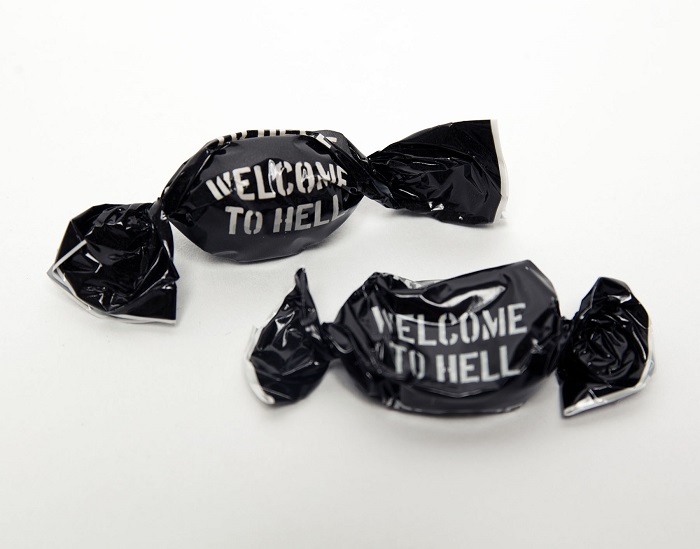
Jill Gibbon, The Etiquette of the Arms Trade
[Welcome sweets] (2016)
Sweet and paper, 2 x 2 x 7 cm
And This Too features seven artists whose work explores, represents or challenges our understanding of contemporary conflict. Their work reflects the diverse and complex issues which surround responses to conflict and includes drawing, painting, sculpture and installation. Much of this work is being exhibited for the first time in Belfast. The exhibition highlights the important role which artists play in offering alternative viewpoints of conflict. Art can change our perceptions or increase our understanding of events. This is crucial, given the current state of heightened security in which we find ourselves.
|
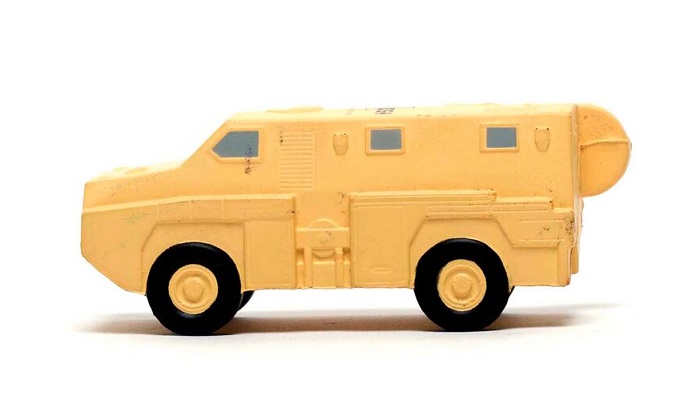
Jill Gibbon, The Etiquette of the Arms Trade
[Stressball Military Vehicle] (2013)
Foam rubber, 5 x 12 x 4.5 cm

Jill Gibbon, The Etiquette of the Arms Trade
[Eurosatory] (2016)
Photography by Tom Fisher
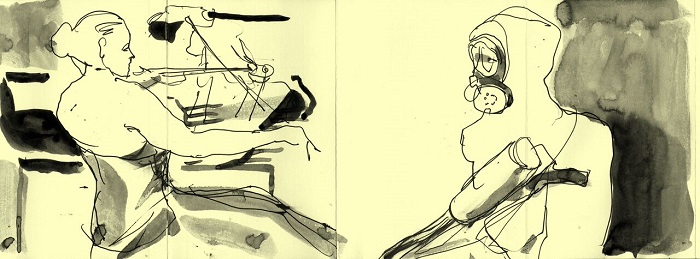
Jill Gibbon, The Etiquette of the Arms Trade
[DSEI Sketchbook 3] (2013)
ink on paper, 14 x 277 cm (fully extended)
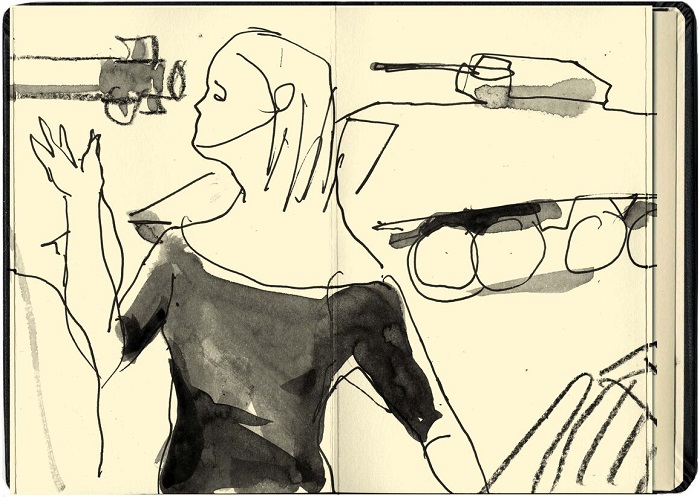
Jill Gibbon, The Etiquette of the Arms Trade
[IDEX Sketchbook 3] (2017)
ink on paper, 14 x 277 cm (fully extended)
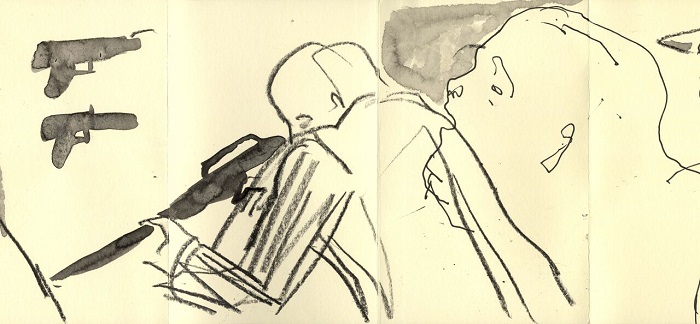
Jill Gibbon, The Etiquette of the Arms Trade
[IDEX Sketchbook 1] (2017)
ink on paper, 14 x 277 cm (fully extended)
Jill Gibbon (1961-) is an English artist/activist who has been involved with anti–war movements since the 1980s. For the past ten years, she has documented the secretive world of the international arms trade by drawing undercover in arms fairs. The world’s largest fair takes place every two years in London Docklands, with similar events in Paris and Abu Dhabi. Here, bombs, tanks, and tear gas are sold to an international clientele including repressive states and repressive regimes, with champagne, classical music, and corporate gifts. Gibbon initially got in by describing herself as an ‘official’ war artist, and more recently, as the managing director of a fictitious arms company. When security saw through her disguise she changed her name, and invented a new business. Her performance as an arms trader has become a fundamental part the project, the suit and paste pearls providing a metaphor for the masquerade of respectability in the industry. ‘And This Too’ presents a selection of Gibbon's sketchbooks, gifts collected from the events, her outfit, and photographs of the performance.
|
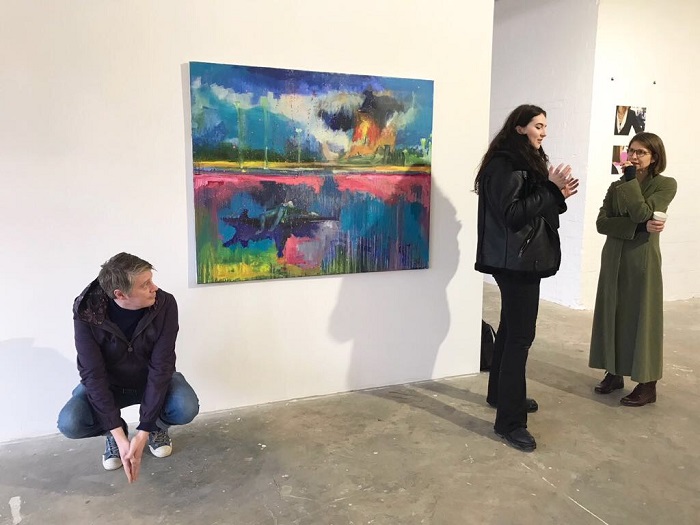
Artist Ciaran Magill beside his painting, Explosion, 2014, oil on linen, 122 x 152 cm
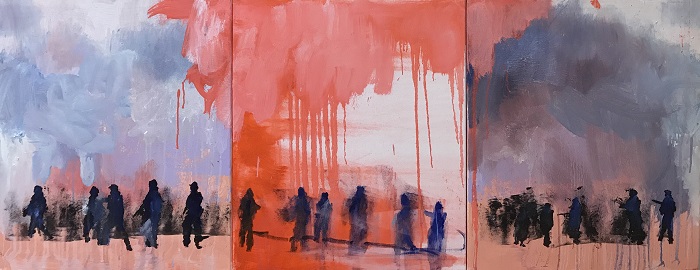
Ciaran Magill, Soldiers, 2017, oil on canvas, 61 x 153 cm
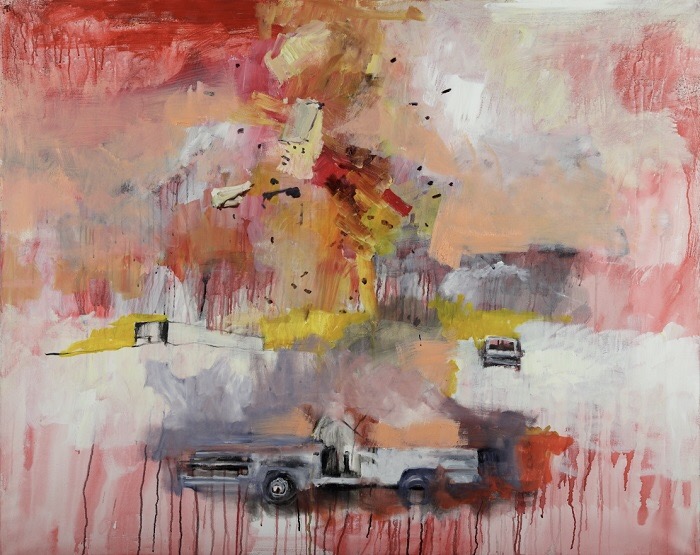
Ciaran Magill, Car Bomb, 2017, oil on linen, 122 x 152 cm
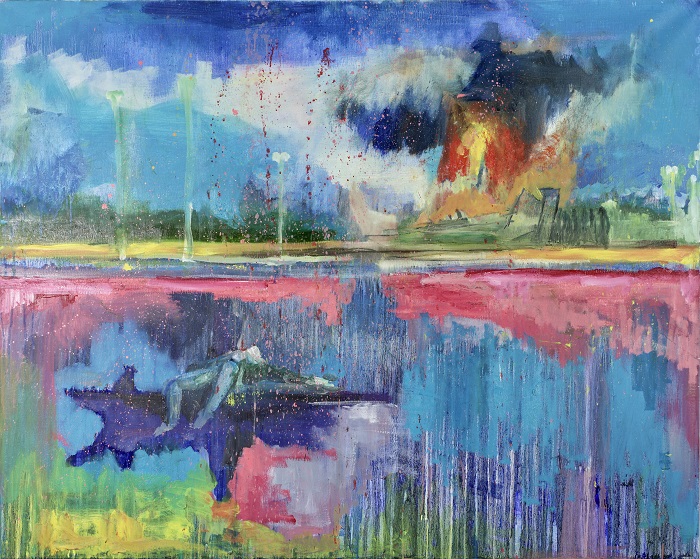
Ciaran Magill, Explosion, 2014, oil on linen, 122 x 152 cm
Ciaran Magill's (1978-) early perception of the landscape as a place of hidden danger is linked to his upbringing in a County Down town which had a heavy military presence. Soldiers often emerged suddenly from the fields or appeared marching alongside the road with weapons in hand. Later in life, another event shaped his relationship with the countryside. An aeroplane crashed in tragic circumstances into a field only two minutes away from the artist's house. In Magill's work, there is an ever-present awareness of violence, whether expressed through vibrant, intensely hued paintings such as Explosion (2014) and Car Bomb (2017), or through more contemplative, muted studies such as Soldiers, 2017.
|
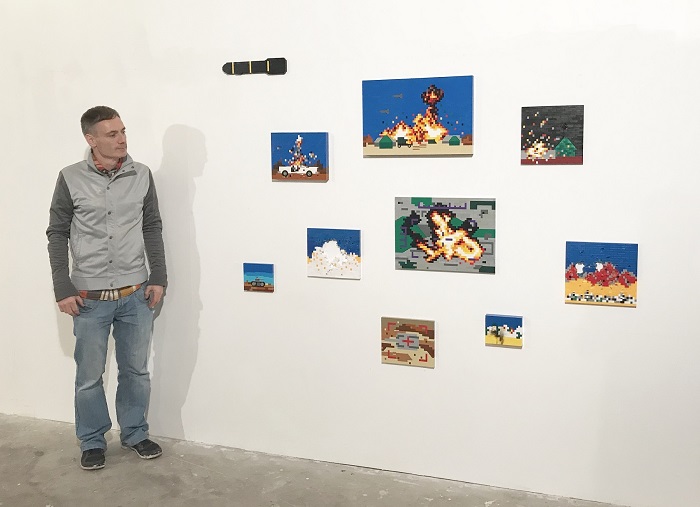
Artist Brendan Jamison beside his Desert Drone Strike Series, 2017, plastic blocks, suite of 10 works, 160 x 200 cm
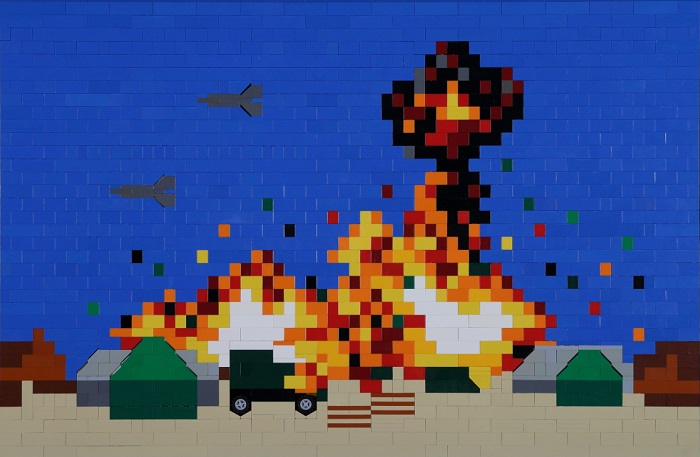
Brendan Jamison, Desert Camp Drone Strike, 2017, plastic blocks, 34 x 51 cm
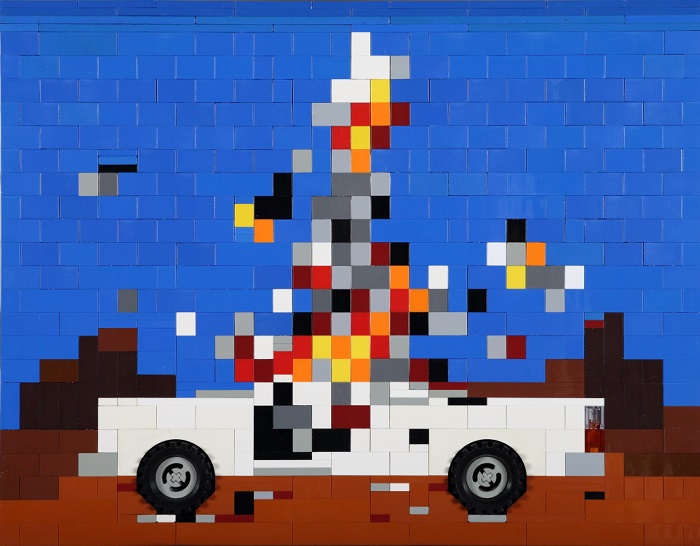
Brendan Jamison, Desert Truck Drone Attack, 2017,
plastic blocks, 22.5 x 28.5 cm
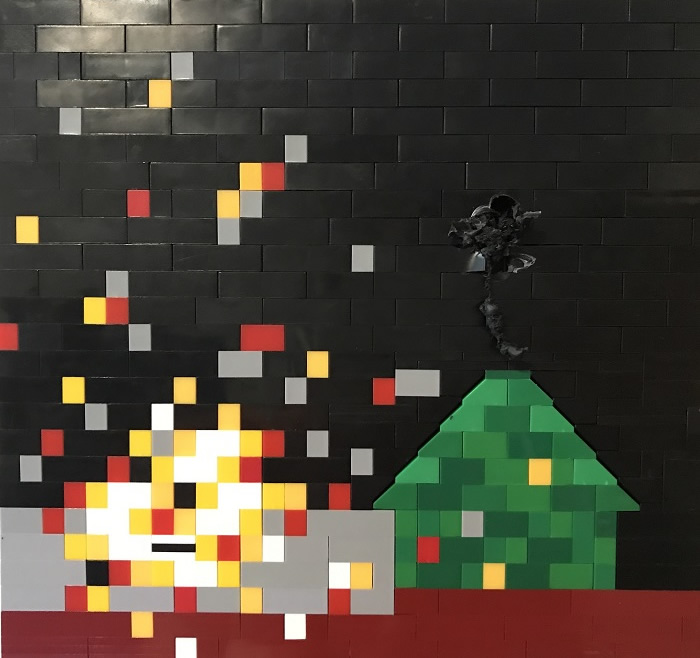
Brendan Jamison, Night Strike at Desert Camp, 2017,
plastic blocks, 24 x 25.5 cm
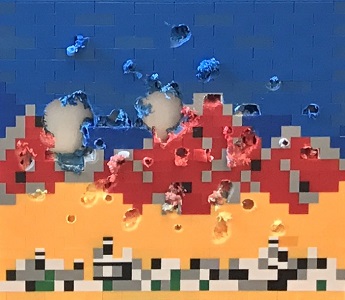 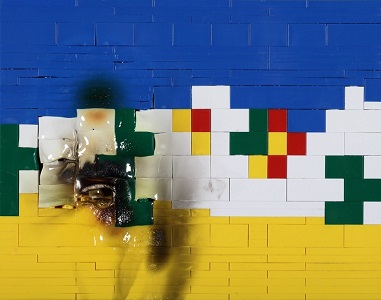
LEFT: Brendan Jamison, Beyond the dunes, the blood red mountains exploded, 2017, plastic blocks, 26 x 28.5 cm
RIGHT: Brendan Jamison, Melted, 2017, plastic blocks, 12.5 x 16 cm
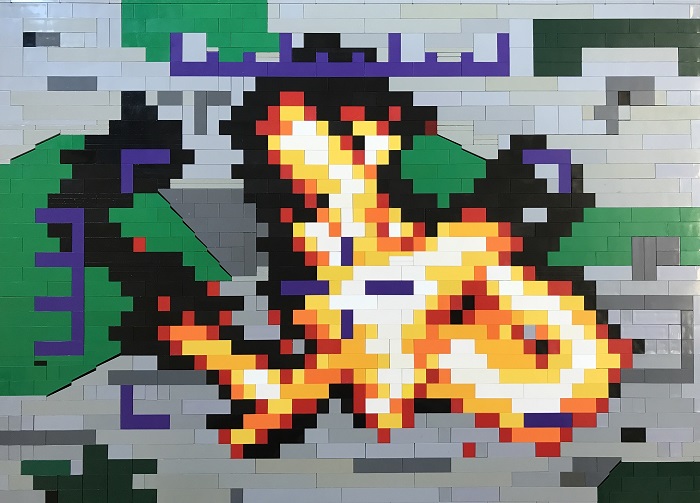
Brendan Jamison, Drone Strike Aerial View from Control Centre, 2017,
plastic blocks, 33.5 x 46 cm
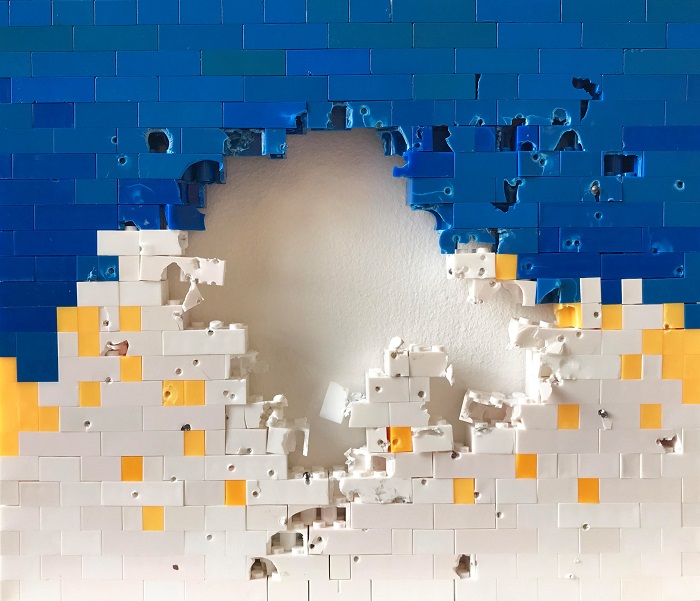
Brendan Jamison, Blown Apart, 2017,
plastic blocks destroyed by shotgun firing, 23 x 27 cm
Brendan Jamison (1979-) has created a new series of works in response to desert drone strikes in the Middle East. The plastic block artworks begin with an aesthetic of pristine surfaces and glorious vibrancy. However, as the series progresses, the imagery becomes more disruptive and distorted as the materials are burnt, melted and torn apart. Like the devastation caused by war itself, the deliberate destruction of the plastic blocks reflect the brutality of bombs and bullets, on both the human body and the environment. However, the absence of figures from each scene references the news footage of such drone strikes whereby it often appears like a scene from a movie, rather than real life. The imagery can also be read as stills from a violent computer game whereby human life becomes extinguished in the blink of an eye. The series reflects on the horrors and tragedy of contemporary warfare but it also explores how we become seduced by the spectacle and hypnotic allure of the warm colours of an explosive detonation, as seen from the comfort and safety of our own homes. |
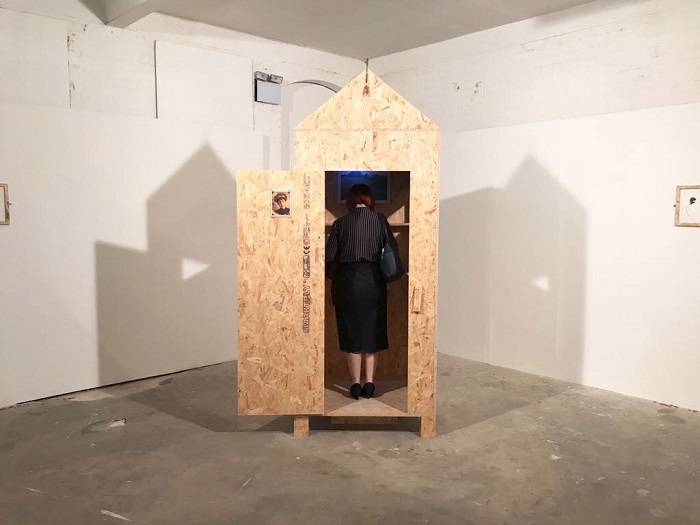
Gail Ritchie, Aporia: A Room for Dwelling and Doubt, 2017,
Mixed media installation, dimensions variable
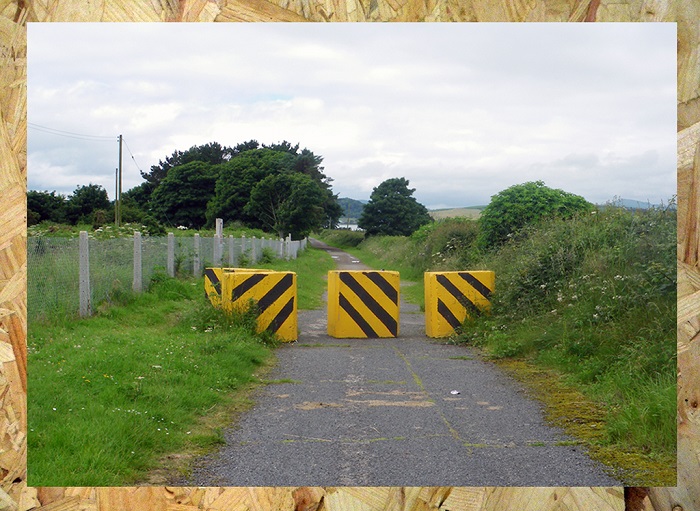
Gail Ritchie, Aporia: A Room for Dwelling and Doubt, 2017,
Mixed media installation, dimensions variable
Detail above: Ballykinler, 2017,
photographic print on aluminium, 36 x 46 cm
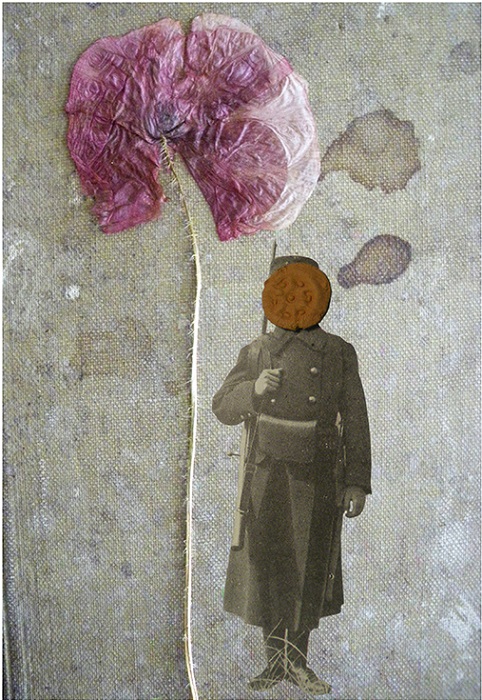
Gail Ritchie, Aporia: A Room for Dwelling and Doubt, 2017,
Mixed media installation, dimensions variable
Detail above: From the book of the Great War, 2017,
mixed media collage, 30 x 20 cm
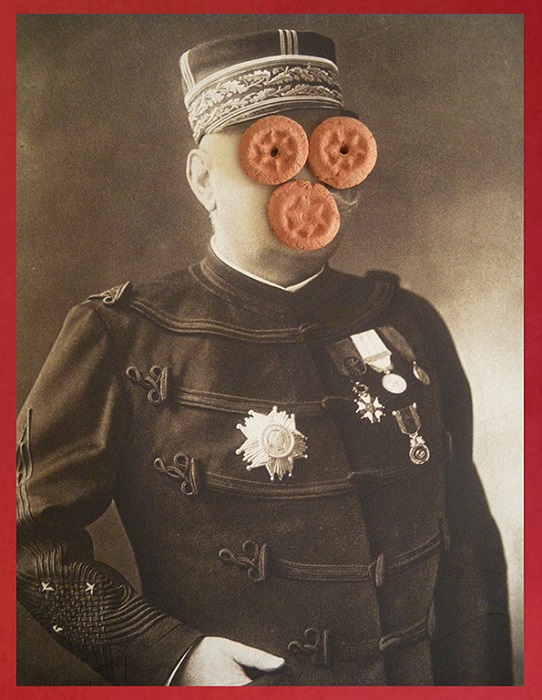
Gail Ritchie, Aporia: A Room for Dwelling and Doubt, 2017,
Mixed media installation, dimensions variable
Detail above: Visual Training, 2017,
mixed media collage, 30 x 20 cm
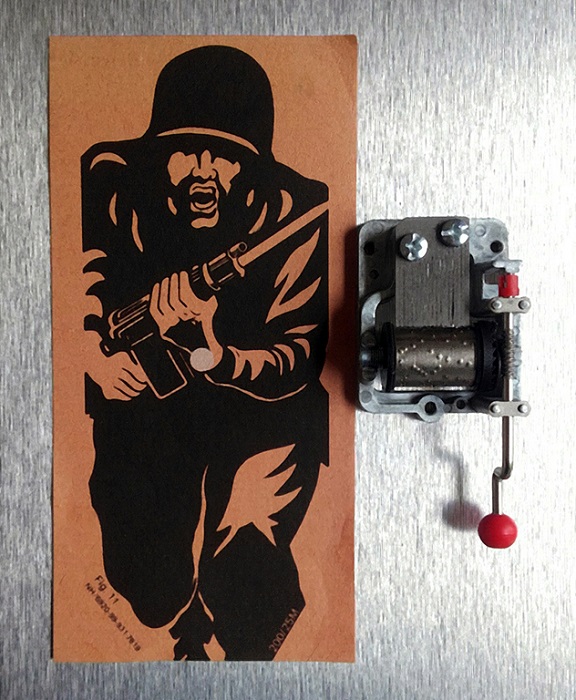
Gail Ritchie, Aporia: A Room for Dwelling and Doubt, 2017,
Mixed media installation, dimensions variable
Detail above: It's a long way, 2017,
paper, aluminium, music box mechanism, 15 x 10 x 5 cm
Gail Ritchie’s (1966-) mixed media installation, in common with much of her work, focuses on meaning and memory in relation to conflict. This can be personal, political or both. The installation is a site of enquiry in which diverse and eclectic representations of conflict (as selected by the artist) are tested and explored. How, for example, do we think of the poppy today? Is it a symbol of remembrance and pride associated with historical conflict or a reminder of 21st century wars, in Afghanistan? Using sound, image and light, Ritchie invites us to enter an intimate constructed space in which the materiality of memory can be considered and questioned. The installation is a template which Ritchie will reuse and adapt over time as part of an ongoing reflection on conflict. It will be shown for the first time as part of ‘And This Too’ in Belfast.
|
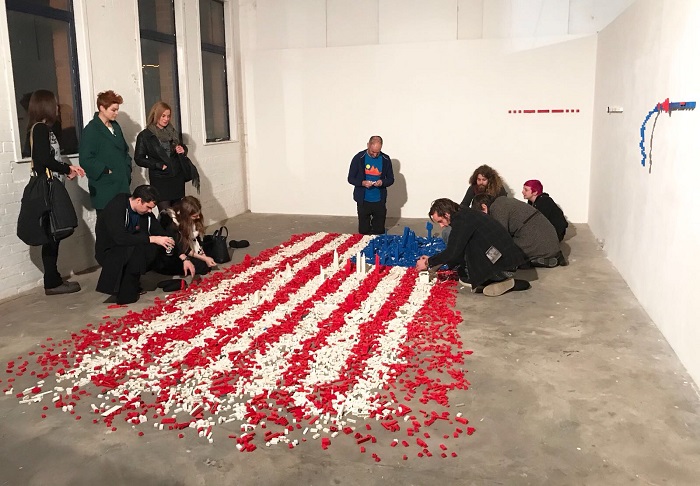
Sean Campbell, I wouldn't start from here..., 2017, interactive Lego installation, 30 x 400 x 200 cm
Sean Campbell (1968 -) recently returned from a three month residency in New York City. Through the studio process of destruction and the resulting scattering of thousands of Lego blocks on the studio floor he opened a conceptual door to a room-scale canvas as a new body of interactive work, with the installation titled ‘I wouldn't start from here...’ Using scattered Lego as unconnected pixels of colour, Campbell has created a representation of the American Flag, often described by Americans as one of the most powerful symbols of freedom and democracy in the Western world. On closer inspection the blocks appear to represent a destroyed city or ‘Legopolis Apocalypse’. Campbell outlines how “The USA is regularly cited as the most powerful nation on earth and spends over $600 Billion annually on defence. Donald Trump is President and the USA is at War, I wouldn't start from here...” |
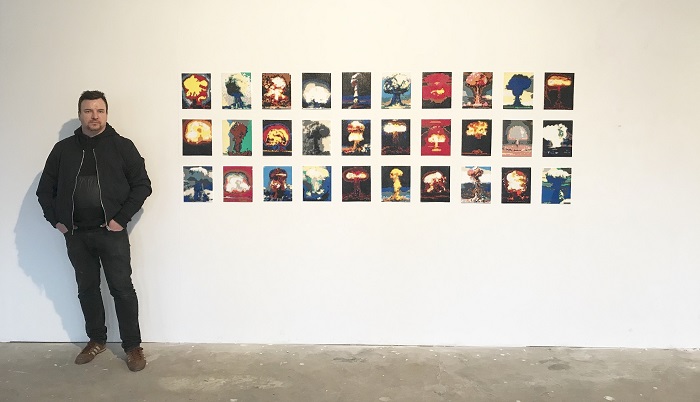
Artist David Turner beside his Continued Small Explosions, 2012-2017, hama beads,
suite of 30 works, 25 x 20 cm each
Over the past 5 years, David Turner (1968-) has created a series of 30 representations of atomic detonations. Employing the vibrancy and playfulness of children's hama beads, 'Continued Small Explosions' is both beautiful and chilling. This duality of the aesthetic attraction offset against the repulsion of something so catastrophic, highlights our terror and fascination with extreme power and destruction. Alarmingly, between 1945 to 1998, there were a total of 2051 nuclear tests throughout the world. During the Cold War, the impeding threat of World War III between the superpowers of America and the USSR had a profound effect on Turner's upbringing. Indeed, the media coverage of global tensions played a much larger impact on his subconscious than the bombs and bullets from the conflict on the streets of Belfast. World leaders, espionage, power-plays and threats of nuclear Armageddon all feed into Turner's art practice. Current political tensions on the international stage seem to have thrown the world back into the paranoia of yet another Cold War era, making this work even more relevant today.
|
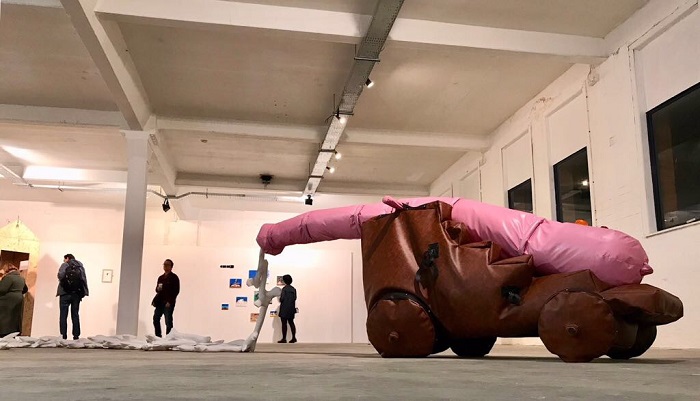
Mark Revels, Canon, 2017,
Installation of stitched vinyl sculpture with felt virus forms,
80 x 70 x 600 cm
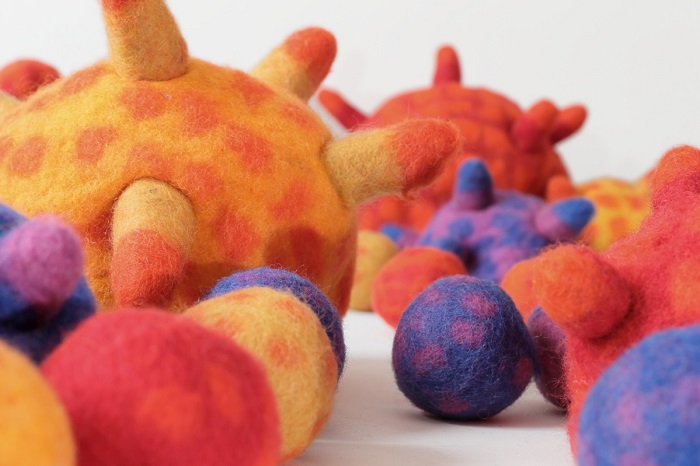
Detail: Mark Revels, Canon, 2017,
Installation of stitched vinyl sculpture with felt virus forms,
80 x 60 x 600 cm
Mark Revels (1978-) has created a life-size canon sewn from pink and brown vinyl. From it, hundreds of textile bones spurt out across the gallery and culminate in a nest of viruses made from felt. War can be seen as a series of contrasts (stand down/stand too; us and them; khaki green/ field grey) and Revels adds to these dichotomies. By contrasting the hard reality of the effects of war (scattered bones) with the use of furniture materials such as vinyl and felt, Revels references armchair politicians and the ease with which they experience war - from a comfortable distance. Battlefields are sites of victory and defeat. Bones can elicit mourning or provide evidence of atrocity. They are reminders of the fragility of the human body and what one person can do to another in the name of war. For Revels, war is a continuum which spreads like a virus; history repeating itself in the ever turning wheel of war.
|
|